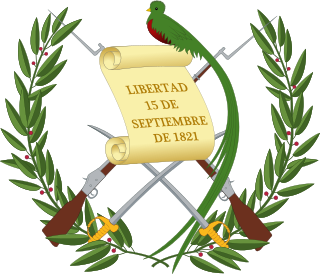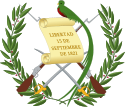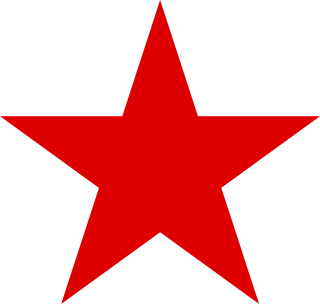
Colonel Jacobo Árbenz Guzmán, nicknamed The Big Blonde or The Swiss for his Swiss origins, was a Guatemalan military officer who was the second democratically elected President of Guatemala from 1951 to 1954. He was a major figure in the ten-year Guatemalan Revolution, which represented some of the few years of representative democracy in Guatemalan history. The landmark program of agrarian reform Árbenz enacted as president was enormously influential across Latin America.

The Guatemalan National Revolutionary Unity is a Guatemalan political party that started as a guerrilla movement but laid down its arms in 1996 and became a legal political party in 1998 after the peace process which ended the Guatemalan Civil War.

The 1954 Guatemalan coup d'état was a covert operation carried out by the U.S. Central Intelligence Agency (CIA) that deposed the democratically elected Guatemalan President Jacobo Árbenz and ended the Guatemalan Revolution of 1944–1954. Code-named Operation PBSUCCESS, it installed the military dictatorship of Carlos Castillo Armas, the first in a series of U.S.-backed authoritarian rulers in Guatemala.
Julio César Méndez Montenegro was the Revolutionary Party President of Guatemala from July 1, 1966 to July 1, 1970. Mendez was elected on a platform promising democratic reforms and the curtailment of military power. The only civilian to occupy Guatemala's presidency during the long period of military rule between 1954 and 1986, Méndez was not allowed to act independently of the military and was widely considered to be a military puppet; Mendez had assumed the presidency under a pact in July, 1966 that gave the armed forces carte blanche with respect to internal security matters and an effective veto over governmental policy. He was the first cousin of César Montenegro Paniagua whose kidnapping, torture and murder during the Julio César Méndez presidency is rumored to have been undertaken with presidential sanction.
Decree 900, also called the Agrarian Reform Law, was a Guatemalan land reform law passed on June 17, 1952, during the Guatemalan Revolution. The law was introduced by President Jacobo Árbenz Guzmán and passed by the Guatemalan Congress. It redistributed unused lands of sizes greater than 224 acres (0.902 km²) to local peasants, compensating landowners with government bonds. Land from at most 1,700 estates was redistributed to about 500,000 families—one sixth of the country's population. The goal of the legislation was to move Guatemala's economy from pseudo-feudalism into capitalism. Although in force for only eighteen months, the law had a major effect on the Guatemalan land reform movement.

The Guatemalan Party of Labour was a communist party in Guatemala. It existed from 1949 to 1998. It gained prominence during the government of Col. Jacobo Arbenz. It was one of the main forces of opposition to the various regimes that followed Arbenz's overthrow and became a constituent of the URNG guerrilla coalition during the later phase of the country's Civil War.

National Directive Nucleus of the Guatemalan Party of Labour, a splinter group of the Guatemalan Party of Labour (PGT). PGT-NDN was formed in 1978, following an internal rift within PGT. An attack of the Military Commission of PGT against a police convoy provoked the split, in which 25 police officers were killed. The central leadership of the party had denied involvement in the attack. A minority accused the leadership of being ambiguous towards the armed struggle against the regime.

Revolutionary Movement 13th November was a leftist movement in Guatemala. MR-13 was founded in 1960 by a group of dissident officers. It grew partly out of the popular protests against the government of President Miguel Ydígoras Fuentes following his election in 1958. It was led by Luis Augusto Turcios Lima, Marco Antonio Yon Sosa and Luis Trejo Esquivel. Alejandro de León, co-founder of the group, was captured and shot by the judicial police in 1961. In 1963, MR-13 joined the Rebel Armed Forces (FAR).
Víctor Manuel Gutiérrez Garbín was a Guatemalan labour leader. Gutiérrez, a school teacher by profession, was head of the Confederación General de Trabajadores de Guatemala (CGTG). Born in Santa Rosa, Guatemala, Gutiérrez was a devout Catholic in his youth, and he was known as a quiet, self-spoken man. He has been referred to as the most important labour leader in Guatemala from 1944 to 1954.

Guatemalan Party of Labour – Communist Party was an underground communist party in Guatemala. PGT-PC was formed in 1978 as a split from the Guatemalan Party of Labour (PGT).
Carlos Quinteros was a Guatemalan communist. Quinteros was a member of the Guatemalan Party of Labour (PGT). When PGT split in 1978 he became a leading figure in the more militant PGT-NDN break-away group. However, he soon left PGT-NDN and joined Guatemalan Party of Labour - Communist Party (PGT-PC). Soon, however he was expelled from PGT-PC.
Bernardo Alvarado Monzón was a Guatemalan communist leader. He led the clandestine Guatemalan Party of Labour (PGT), and became its general secretary. Under Alvarado's leadership the party adopted the line of "Popular Revolutionary War."
Rogelia Cruz Martínez was a Guatemalan left-wing activist, the 1958 Miss Guatemala Universe winner, and Guatemala's representative in the 1959 Miss Universe pageant. She was murdered by a paramilitary death squad at the age of 27, reportedly due to her political activities.
Operation PBHistory was a covert operation carried out in Guatemala by the United States Central Intelligence Agency (CIA). It followed Operation PBSuccess, which led to the overthrow of Guatemalan President Jacobo Árbenz in June 1954 and ended the Guatemalan Revolution. PBHistory attempted to use documents left behind by Árbenz's government and by organizations related to the communist Guatemalan Party of Labour to demonstrate that the Guatemalan government had been under the influence of the Soviet Union, and to use those documents to obtain further intelligence that would be useful to US intelligence agencies. It was an effort to justify the overthrow of the elected Guatemalan government in response to the negative international reactions to PBSuccess. The CIA also hoped to improve its intelligence resources about communist parties in Latin America, a subject on which it had little information.
The Party of the Guatemalan Revolution was formed in June 1952 during the Guatemalan Revolution to unite the non-Communist parties which were supporting the administration of Jacobo Árbenz. These included the Popular Liberation Front, the National Renovation Party, the Revolutionary Action Party, and the Socialist Party. The Communist Guatemalan Party of Labour (PGT) was opposed to the formation of the PRG, fearing that it would undermine their influence in the government. The PAR and the PRN later withdrew. Although the PRG continued in existence until the overthrow of the President Árbenz, it had failed to achieve its original purpose of opposing Communist efforts to gain a predominant voice in the Árbenz government. It was disbanded after the coup d'état of 1954.
Revolutionary Action Party was a leftist political party in Guatemala during the ten-year Guatemalan Revolution. Formed in 1945, the party went through a series of mergers and fractures before dissolving in 1954 after the United States-backed coup d'état.
Labour Party or Labor Party may refer to:
Ricardo Rosales Román was the head of the Guatemalan Party of Labour (PGT) beginning in 1974 through 1998. His nom de guerre was Carlos González. Rosales joined the leadership of the URNG in 1986. The PGT disbanded in 1998 after the conclusion of the country's civil war.
José Manuel Fortuny Arana was an important communist leader in Latin America. He became well known for his friendship with Guatemalan President Jacobo Árbenz, and was one of the main advisers in his government, which lasted from 1951–54. Árbenz was overthrown by a coup engineered by the United States in 1954, an event which drove Fortuny into exile, along with many of his comrades.
Patriotic Labour Youth was the youth wing of the Guatemalan Party of Labour (PGT) from the late 1950s to 1981. JPT was a member of the World Federation of Democratic Youth (WFDY).










